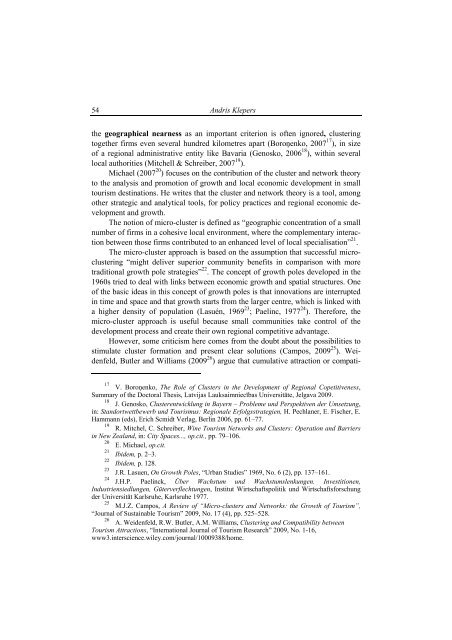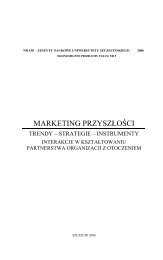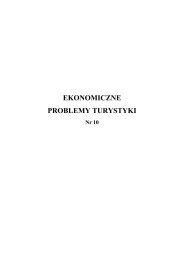Zeszyt naukowy - caÅoÅÄ - WydziaÅ ZarzÄ dzania i Ekonomiki UsÅug
Zeszyt naukowy - caÅoÅÄ - WydziaÅ ZarzÄ dzania i Ekonomiki UsÅug
Zeszyt naukowy - caÅoÅÄ - WydziaÅ ZarzÄ dzania i Ekonomiki UsÅug
Create successful ePaper yourself
Turn your PDF publications into a flip-book with our unique Google optimized e-Paper software.
54<br />
Andris Klepers<br />
the geographical nearness as an important criterion is often ignored, clustering<br />
together firms even several hundred kilometres apart (Boroņenko, 2007 17 ), in size<br />
of a regional administrative entity like Bavaria (Genosko, 2006 18 ), within several<br />
local authorities (Mitchell & Schreiber, 2007 19 ).<br />
Michael (2007 20 ) focuses on the contribution of the cluster and network theory<br />
to the analysis and promotion of growth and local economic development in small<br />
tourism destinations. He writes that the cluster and network theory is a tool, among<br />
other strategic and analytical tools, for policy practices and regional economic development<br />
and growth.<br />
The notion of micro-cluster is defined as “geographic concentration of a small<br />
number of firms in a cohesive local environment, where the complementary interaction<br />
between those firms contributed to an enhanced level of local specialisation” 21 .<br />
The micro-cluster approach is based on the assumption that successful microclustering<br />
“might deliver superior community benefits in comparison with more<br />
traditional growth pole strategies” 22 . The concept of growth poles developed in the<br />
1960s tried to deal with links between economic growth and spatial structures. One<br />
of the basic ideas in this concept of growth poles is that innovations are interrupted<br />
in time and space and that growth starts from the larger centre, which is linked with<br />
a higher density of population (Lasuén, 1969 23 ; Paelinc, 1977 24 ). Therefore, the<br />
micro-cluster approach is useful because small communities take control of the<br />
development process and create their own regional competitive advantage.<br />
However, some criticism here comes from the doubt about the possibilities to<br />
stimulate cluster formation and present clear solutions (Campos, 2009 25 ). Weidenfeld,<br />
Butler and Williams (2009 26 ) argue that cumulative attraction or compati-<br />
17<br />
V. Boroņenko, The Role of Clusters in the Development of Regional Copetitiveness,<br />
Summary of the Doctoral Thesis, Latvijas Lauksaimniecības Universitāte, Jelgava 2009.<br />
18<br />
J. Genosko, Clusterentwicklung in Bayern – Probleme und Perspektiven der Umsetzung,<br />
in: Standortwettbewerb und Tourismus: Regionale Erfolgsstrategien, H. Pechlaner, E. Fischer, E.<br />
Hammann (eds), Erich Scmidt Verlag, Berlin 2006, pp. 61–77.<br />
19<br />
R. Mitchel, C. Schreiber, Wine Tourism Networks and Clusters: Operation and Barriers<br />
in New Zealand, in: City Spaces..., op.cit., pp. 79–106.<br />
20<br />
E. Michael, op.cit.<br />
21<br />
Ibidem, p. 2–3.<br />
22<br />
Ibidem, p. 128.<br />
23<br />
J.R. Lasuen, On Growth Poles, “Urban Studies” 1969, No. 6 (2), pp. 137–161.<br />
24<br />
J.H.P. Paelinck, Über Wachstum und Wachstumslenkungen. Investitionen,<br />
Industriensiedlungen, Güterverflechtungen, Institut Wirtschaftspolitik und Wirtschaftsforschung<br />
der Universität Karlsruhe, Karlsruhe 1977.<br />
25<br />
M.J.Z. Campos, A Review of “Micro-clusters and Networks: the Growth of Tourism”,<br />
“Journal of Sustainable Tourism” 2009, No. 17 (4), pp. 525–528.<br />
26<br />
A. Weidenfeld, R.W. Butler, A.M. Williams, Clustering and Compatibility between<br />
Tourism Attractions, “International Journal of Tourism Research” 2009, No. 1-16,<br />
www3.interscience.wiley.com/journal/10009388/home.

















